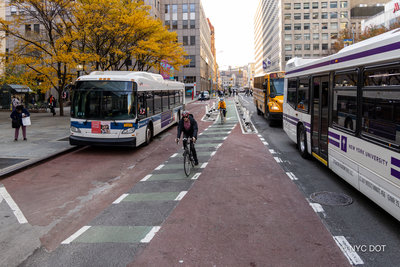Community discusses Bus Network Redesign
As part of their public outreach efforts, the MTA is holding workshops in each community district — from Astoria to Rockaway — to hear feedback about their Queens Bus Network Redesign Plan.
After an 18-month pause on the project, which was initially developed in 2019, the MTA released the most updated draft.
They said in a presentation that after the recent public outreach has been completed, that feedback will be analyzed and implemented into a proposed final plan.
The goal of the Bus Network Redesign is to modernize the city’s bus network and provide faster, more efficient service to the nearly 800,000 customers who rely on it.
The plan is slated to eliminate a total of 1,685 bus stops, as well as offer 85 routes to the borough.
Residents of Community District 5 — which covers Ridgewood, Glendale, Middle Village and Maspeth, had the opportunity to provide feedback to MTA representatives at last Wednesday’s virtual workshop, and many of them were quite skeptical about the plan.
“The proposed change to the Q39 removing all service in Ridgewood removes access to several colleges not served by the Q67,” one concerned resident said. “Q67 frequency is 30 minutes, which does not improve Q39 service. The only option would be the Q58, which is already overcrowded, and transfer to the Q39 somewhere.”
The proposed Q39 would be extended north to Astoria via 21 Street and Astoria Blvd, replacing Q103 service there, and providing new connections across western Queens.
It would also terminate in Maspeth instead of serving Ridgewood, which would be provided by the potential Q67 bus. It will also no longer operate on a 24-hour timeline.
As part of the plan, the MTA created online profiles for each individual bus route in Queens in order for customers to analyze the proposals in depth.
The profiles suggest alternate connections by bus and train to compensate for any service that was changed or eliminated, as well as average stop spacing, total length, proposed frequency and span, and a map to provide a visual guide for the route’s changes.
Another Ridgewood resident pointed out that a stop on Menahan Street and Fresh Pond Road along the Q58 has been skipped as a result of nearby construction and stressed that it needs to be addressed in the new plan.
The same resident also brought up an error in the MTA’s plan regarding the QM24 and QM25 buses, which say there will be a stop on Fresh Pond Road and Gates Avenue, however, there is currently no bus stop at Gates Avenue.
“I think that was just an error because there is a stop at Fresh Pond and Grove, and that would make perfect sense to keep the bus stop there. But if you remove the bus stop at Bleecker Street and move the Grove stop, it’s such a tremendous difference to be able to walk all the way over to Gates Avenue,” she said.
Lucille Songhai, an MTA representative, said she and other employees will continue to do research regarding the road operations, which will likely be reflected in the final plan.
MTA representative Daniel Randall reminded all attendees that the current plan is merely a draft at this point, and that all feedback, questions, and concerns are welcome.
“All this feedback is very useful,” he said. “You know your communities better than we do.”
Randall added that “the fact that you’re naming economic institutions, schools, and local infrastructure is really helpful because that will inform the next phase of this plan.”
More information about the Queens Bus Network Redesign Plan is available on the MTA’s website for anyone to view. Community members can register for any of the MTA’s virtual bus workshops through June 2 as well.








